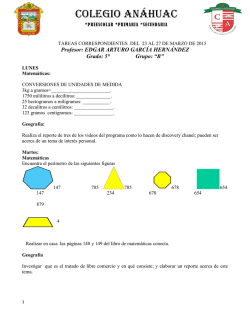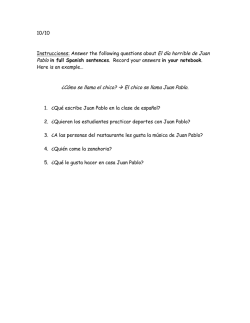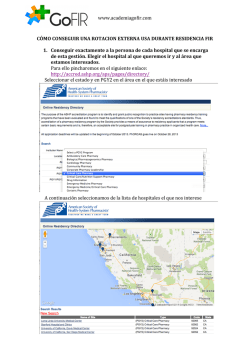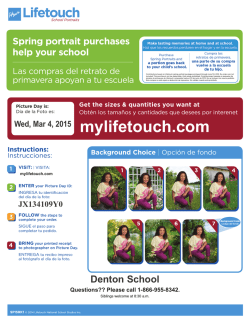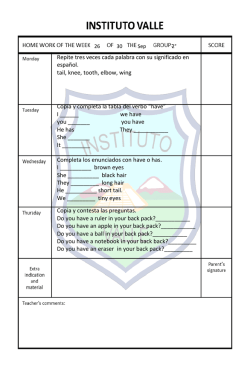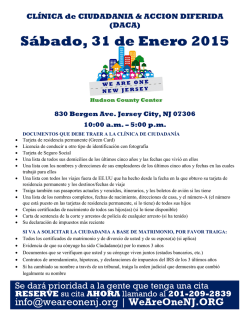
Crutches - Children`s Hospitals and Clinics of Minnesota
Muletas (Spanish) Crutches (English) ¿Por qué son necesarias las muletas? Why do I need crutches? Las muletas se usan para no poner peso sobre la pierna o el pie lesionados o debilitados, de manera que puedan sanar. Para evitar accidentes, las muletas deben ajustarse a la medida correcta. Crutches are used to help keep weight off your injured or weak foot or leg so it can heal. They must be adjusted to the right length for you to use safely. ¿Qué medida deben tener las muletas? How long should my crutches be? Mida el largo de las muletas, tal como se explica a continuación: Check the fit (length) as follows: 1. Párese derecho con las muletas a los costados a unas seis pulgadas (15 cm) de distancia del cuerpo y seis pulgadas por delante del pie. Debe haber unas dos pulgadas (dos o tres dedos de ancho) entre el tope de las muletas y la axila. Los hombros deben permanecer relajados. Es necesario que las muletas tengan la medida correcta para evitar que produzcan presión y dañen los nervios del área. 1. Stand up tall with each crutch 6 inches out from your side and 6 inches in front of your foot. There should be about 2 inches of space (2 or 3 fingers’ width) between the top of the crutches and your armpits. Be sure your shoulders are relaxed. Correct fit helps prevent pressure and nerve damage. 2. Párese derecho, mirando hacia adelante, con los brazos a los lados. Las empuñaduras de las muletas deben quedar a la altura de las muñecas. (Al sujetar las empuñaduras, los brazos deben quedar ligeramente doblados.) 2. Stand tall, look straight ahead, and hang your arms at your sides. The handgrips on the crutches should be level with your wrists. (Elbows should be slightly bent when your hands are on the handgrips.) 3. Si las muletas no son del tamaño apropiado, llame al lugar donde las obtuvo. 3. If the crutches do not fit, contact the place where you received them. Crutches –Spanish/English - Page 1 of 6 Cuánto peso se puede poner sobre la pierna? How much weight can I put on my leg? Sobre la pierna lesionada (Put only as much weight on your hurt leg) [___ izquierda (left) ___ derecha (right)] d deberá poner sólo el peso que le haya indicado el médico, según se explica a continuación (as directed by your doctor-see chart below): Instrucciones del médico: No poner peso. Doctor’s directions: Non-weight-bearing. Lo que debe hacer: No pisar con la pierna lesionada. Poner peso mínimo. Minimal weightbearing. Poner peso ligero, solamente en la punta del pie. Toe touch. Apoyar el pie ligeramente en el piso al caminar. Apoyarse ligeramente en la punta del pie al caminar. Poner peso parcial. Partial weightbearing. Poner peso según se tolere. Weight-bearing to tolerante. ¿Cómo se camina con muletas? This means: No stepping on hurt leg. Very light step. Place front of foot down only, using a light sep. Put about half of your weight on hurt leg. Apoyar aproximadamente la mitad de su peso en la pierna lesionada. Let comfort guide how El dolor le indicará cuánto peso much weight to apply. puede poner. How do I walk with the crutches? 1. Párese derecho, con buena postura. Mire hacia adelante, no hacia abajo. 1. Stand tall with good posture. Look ahead, not down at the floor. 2. Dé un paso hacia adelante con las muletas (y la pierna lesionada, si se le permite poner peso sobre ella); las manos deben sostener su peso en las muletas. 2. Step forward with the crutches (and your hurt leg if some weight bearing is allowed), hands supporting your weight on your crutches. 3. Dé un paso más allá de la punta de las muletas con la pierna sana. 3. Step past the crutch tips with your strong leg. 4. Repita los pasos dos y tres. 4. Repeat 2 and 3. Crutches –Spanish/English - Page 2 of 6 ¿Cómo se suben y bajan escaleras? How should I go up and down stairs? Para subir escaleras sin pasamanos: primero apoye el pie luego las muletas. Going upstairs without a handrail: “Foot first going up” Si necesita ayuda, otra persona deberá pararse detrás de usted, con los pies bien separados y en escalones diferentes, para tener más estabilidad. If you need help, someone should stand behind you, with feet wide apart and on separate steps to be stable. 1. Sosténgase poniendo el peso en las muletas y dé un paso hacia arriba con la pierna sana. 1. Push down on the crutches and step up with the strong leg. 2. Lleve las muletas y la pierna lesionada hacia el mismo escalón. 2. Bring your crutches and hurt leg up to the same step. 3. Continúe subiendo las escaleras. 3. Continue with each step. Para bajar escaleras sin pasamanos: primero las muletas luego el pie. Going downstairs without a handrail: “Crutches first going down” Si necesita ayuda, otra persona deberá pararse delante de usted, con los pies bien separados y en escalones diferentes, para tener más estabilidad. If you need help, someone should stand in front of you, with feet wide apart and on separate steps to be stable. Crutches –Spanish/English - Page 3 of 6 1. Dé un paso hacia abajo con las muletas (y la pierna lesionada, si le permiten poner peso sobre ella). 1. Step down with the crutches (and the hurt leg if some weight bearing is allowed). 2. Dé un paso hacia el mismo escalón con la pierna sana. 2. Step down to the same step with the strong leg. 3. Siga bajando las escaleras. 3. Continue with each step. Escaleras con pasamanos Stairs with a handrail Ponga la mano en el pasamanos. Con el otro brazo, sostenga ambas muletas como si fueran una (o, de ser posible, pídale a alguien que le sostenga una muleta). Siga las instrucciones indicadas anteriormente. (Si tiene dificultad para agarrar ambas muletas como se muestra, trate de cruzarlas en forma de “T”.) Put your hand on the handrail. With your other arm, use both crutches as one—or better yet, have someone carry your spare crutch for you. Use the same pattern described above. (If you have trouble holding the crutches together as shown, try crossing them like the letter “T.”) Crutches –Spanish/English - Page 4 of 6 ¿Cómo hay que sentarse? How should I sit down? 1. Retroceda hasta tocar la silla con la parte de atrás de la pierna. Retire las muletas de debajo de la axila y colóquelas juntas del lado de la pierna lesionada, sosteniéndose de la empuñadura (ver la figura). 1. Back up until you feel the chair at the back of your leg. Take the crutches from under your arms. Put both crutches in the hand on your injured side, holding at the handgrip (see picture). 2. Apóyese en el asiento o el brazo de la silla con la otra mano. 2. Reach back for the chair seat or arm with the other hand. 3. Siéntese lentamente. 3. Sit down slowly. ¿Cómo hay que pararse? How do I get up? 1. Coloque ambas muletas cerca de la silla del lado de la pierna lesionada (ver la figura de arriba). 1. Hold both crutches by the chair on your injured side (see picture above). 2. Slide to the edge of the chair. 2. Deslícese hasta el borde de la silla. 3. Apóyese en el asiento o el brazo de la silla y use la pierna sana para pararse. 3. Push down on the seat or arm of the chair and use the strong leg to stand up. 4. Cuando esté de pie bien equilibrado, ponga las muletas debajo de los brazos. 4. When you are standing with good balance, then put the crutches under your arms. ¿Cómo se sube a un automóvil? How should I get into the car? 1. Retroceda hasta el borde del asiento. 1. Back up to the edge of the seat. 2. Siéntese como se describe arriba. 2. Sit down as described above. Crutches –Spanish/English - Page 5 of 6 3. Gire el cuerpo para meter las piernas al automóvil. 3. Then pivot around, bringing your legs into the car. Para salir, gire hasta sacar las piernas del automóvil; póngase de pie tal como lo haría de estar sentado en una silla. To get out, pivot to bring your legs out of the car. Then stand up as if from a chair. Información importante What else do I need to know? Cuando tenga las muletas puestas, nunca apoye su peso en las axilas. Never lean on the tops of the crutches with your armpits. Tenga mucho cuidado cuando camine sobre hielo, en la lluvia, sobre alfombras sueltas o alrededor de mascotas pequeñas, así como en otras situaciones en las que exista el riesgo de caerse. Take extra care on ice, in wet weather, around scatter rugs or small pets, or in other situations when you could fall. Póngase zapatos cómodos, con suela de goma que no resbale. Lo más recomendable es ponerse zapatos que ya haya usado por un tiempo y no le molesten. No use sandalias ni pantuflas. Wear comfortable shoes with a "good grip" sole. A “broken in” favorite pair of shoes is best. Do not wear sandals or slippers. No debe jugar con las muletas ni permitir que otros lo hagan. Do not play with your crutches or allow others to do so. Verifique regularmente que las muletas: Check your crutches now and then. • • • • • • no tengan tierra ni piedras en la punta no tengan las puntas gastadas tengan los tornillos y tuercas bien apretados Are the tips free of dirt or rocks? Have the tips worn out? Are all wing-nuts and buttons tight? ¿Tiene otras preguntas? Questions? Esta hoja informativa sólo le ofrece información general; no es específica para su hijo. Si tiene alguna otra pregunta, consulte al médico o al fisioterapeuta del niño. These instructions are not specific to your child, but provide general information. If you have any questions, please call your child’s doctor or physical therapist. Children’s Hospitals and Clinics of Minnesota Patient/Family Education 2525 Chicago Avenue South Minneapolis, MN 55404 Last Reviewed 6/2013 Copyright Crutches –Spanish/English - Page 6 of 6
© Copyright 2025
